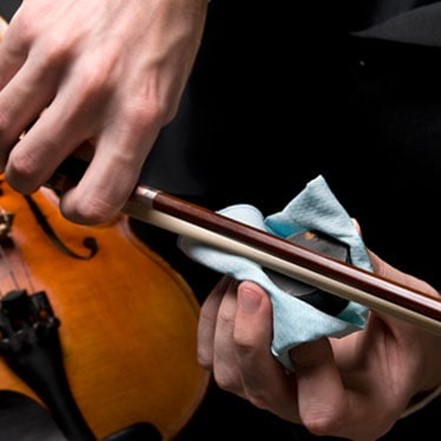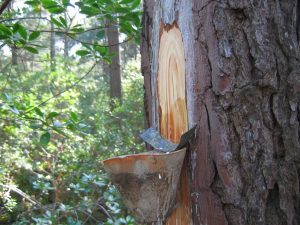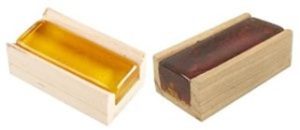
What is the purpose of applying rosin to your violin bow?
Contents
What is violin rosin?
Rosin, also known as colophony, is a solid form of resin made from the distillation of various substances, including turpentine and oleoresin (or gum).
Oleoresin is a liquid extract obtained from resinous trees, such as pines, through a process known as pine-tapping. The Landes region of France has long been the largest rosin producer in Europe, thanks to its massive coniferous forests.
Pine-tapping, on the other hand, has been slowly disappearing from the Landes region due to foreign competition, primarily from Spain and Portugal.
Although rosin production has reached global levels – each country can now produce its own rosin – quality varies greatly between countries.
What does rosin on a violin bow do?
Any musician who plays a fretted string instrument, such as the violin or cello, needs rosin. It’s also required for anyone who plays an electric violin or viola.
The hair on the bow will slide across the strings if there isn’t enough rosin, and no sound will be produced. The violinist must rub the rosin along the entire length of the bow to allow the bow hairs to generate a grip on the violin strings and thus produce a sound.
To play the violin, viola, or any fretted string instrument, rosin is required!
How do you put rosin on your violin bow?
You’ll need to rosin the bow before any rehearsal or performance. For any musician who plays a fretted string instrument, this simple gesture must become part of the routine.
- Tighten the bow hairs as usual.
- Use your left hand to hold the rosin and your right hand to hold the bow. Then, with no pressure, begin applying the rosin to the hairs.
- Actually, all you need to do is rub the bow hairs up and down on the rosin gently.
- It’s important not to use too much rosin because it’ll be useless. Only make one or two back-and-forth movements across the bow. Apply a little more rosin if your bow is brand new. If the rosin is new, applying it to the bow may be more difficult; if this is the case, rub the rosin on the bow for a few more seconds.
If you’re not sure how much rosin to use, try your bow on the violin strings to see how much you need. A block of rosin has a one-year shelf life, according to the manufacturer’s instructions. On the other hand, we use it for a longer period of time – sometimes up to 5 years.
In the event that rosin dust particles have accumulated on your violin, how should you clean it?
Old rosin residues accumulate on your violin body as you play, forming a layer of rosin dust particles. It is preferable to clean your violin on a regular basis to avoid causing damage to its body.
The rosin, in fact, has the potential to scratch or damage the violin varnish. To do so, simply wipe the rosin away with a soft, clean, and dry piece of cloth.
What’s the difference between light and dark rosins?
Light rosin is typically harder and produces a “softer” sound. It is preferred by violinists and violists. Dark rosin, on the other hand, is “softer and stickier.”
It is preferred by cellists and double bassists over light rosin. Because cello and double bass bows have more hairs, the dark rosin applies better with this stickier residue.
The consistency of rosin will affect the sound produced by the instrument, even if the difference in sound is almost imperceptible.
The temperature used during the distillation process determines the color of rosin. Each brand has its own manufacturing process, which results in a variety of rosins.
Please keep in mind that additives can be used during the fabrication process, changing the final color.
What type of rosin should I use?
There’s no mystery here; simply try different rosins on your violin bow and strings to find the one that works best for you. It’s worth noting that the end result is also influenced by the type of strings you use: gut vs. steel.
However, there are a few exceptions:
- If you’re a complete beginner, entry-level rosins will suffice. As you gain experience, feel free to experiment with different types of rosins.
- The dust generated by rubbing can aggravate or trigger allergy symptoms. If you’re allergic to rosin, you should know that there are hypoallergenic rosins available. In just a few clicks, you can find them on the Internet!
- Rosin does not melt, but it can become softer in hot weather. The darker the color, the more heat resistant it is. If you live in a hot country, this is a major consideration.
Violin rosin FAQs
What happens if a bow isn’t rosined?
Without rosin, a bow will not make a sound and will aimlessly glide around on the strings while you try to play.
How can I tell if my bow requires rosin?
There are two possibilities: As an acoustic test, you should strike the bow across the strings. The bow hair does not have enough rosin if it does not slide easily and makes no sound or only a faint, thin sound.
However, if the bow is very scratchy, it may have accumulated too much rosin.
How frequently do you replace your rosin?
In general, we find that players reapply rosin once every 4-6 hours of continuous play.
- Viola vs Violin – 5 Key Differences Between The Two Instruments - March 20, 2024
- 15 of the Most Famous Violinists of All Time (18th Century to Present) - March 20, 2024
- Full School Band Instruments List (Elementary / Middle / High) - March 18, 2024



